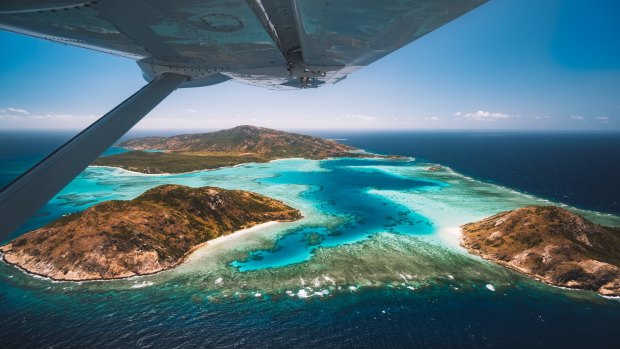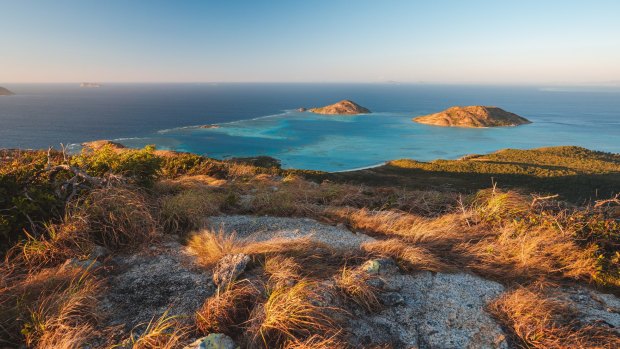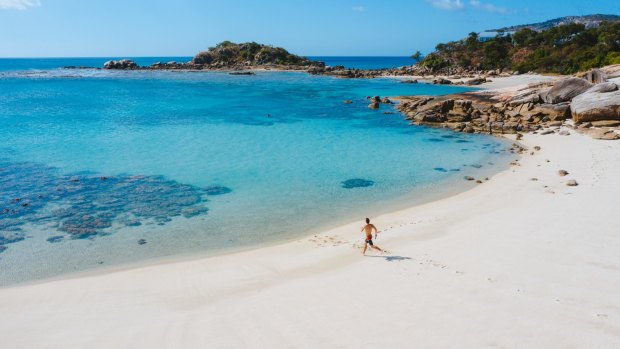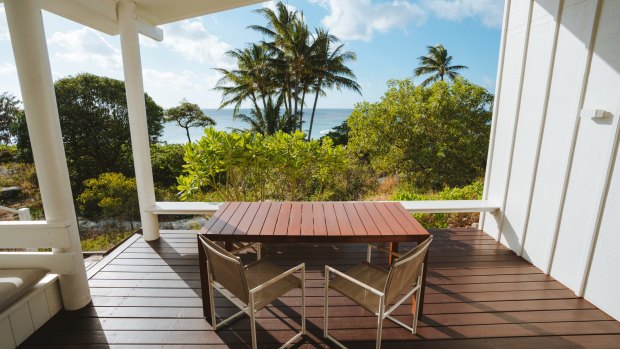This was published 2 years ago
Lizard Island: The spectacular Aussie island that once wasn't an island at all
By Catherine Marshall

Ten thousand years ago Lizard Island was part of the Australian mainland.Credit: Tourism and Events Queensland
It takes a lot of steam to summit utopia, though I've left at dawn, even before the birds have started singing. No-one stirs on the yachts moored out in the bay; the sun rises swiftly, tarnishing the undersides of buttermilk clouds so they look like the fiery contrails of supersonic jets.
Over Chinaman's Ridge and down the sandy track I go, through soggy paperbark swamp (do crocodiles lurk here, I wonder?), along the beach past the ruins of Watson's Cottage and up the granite rocks on the opposite side. The final ascent is a slippery scramble; I catch my breath and write my name triumphantly in the visitor's book tucked into a box beside a cairn.
"Just look at the view!" I scribble in a sweaty hand.

The island's summit AKA Cook's Look.Credit: Tourism and Events Queensland
And what a view it is. From here the Great Barrier Reef billows in every direction, like a radiantly twirling ball-gown; its pattern is a puzzle of malachite reefs enclosed in collars of neon blue. If I'd arrived 10,000 years earlier, there'd be no water within view at all. Instead, the hillock on which I'm standing would slope gently eastwards before slipping 20 kilometres yonder into the Coral Sea. Behind me, waves of grass and dunes would be rolling all the way to the south-western mainland.
The ocean has long-since breached the barrier, creating lagoons filled with kaleidoscopic reef fish and languorously swirling corals. Somewhere out in the blue is the fabled Cod Hole, where just yesterday we snorkelled in the hope of sighting potato cod; the hulking, fat-lipped creatures were playing hard to get, so we'd sailed to another spot where the marine life was more engaging: jailbird-clothed sergeants and sunny-tailed fusiliers, coral fish with birdlike beaks and blue-eyed cardinals streaking by in flashes of lapis lazuli.
My visit to the Lizard Island Research Station – a short boat ride from Lizard Island Resort, during which we tracked turtles gliding in the shallows – had given me a greater appreciation for this reef and its urgent need for conservation. COVID notwithstanding, the station hosts around 100 research projects each year, each of them facilitating essential research and education.

Sunset Beach.Credit: Tourism and Events Queensland
"All the science is saying major [coral] bleaching events are becoming more common," says Dr Lyle Vail, director of the station.
And though he believes the reef faces a difficult future, he remains hopeful of its longevity.
"Coral reefs really want to regenerate, and if you give them enough time they'll come back to what they've been," he says.

Lizard Island Resort.Credit: Tourism and Events Queensland
It was the reef's stubborn existence that brought Captain James Cook to the island's summit (now named Cook's Look) in 1770 when his ship, the Endeavour, became trapped within its labyrinthine cays. From this vantage point, he was able to puzzle a passage out of it. All he could see on the island were lizards, prompting him to name this place for them. But hidden within the scrub and granite were middens and other artefacts testifying to another, far older occupation: the Dingaal people had lived here before the ocean rose, and had continued to hold sacred initiation ceremonies on this island they'd named Jiigurru.
If Cook had looked southwards from up here he might have imagined the spot where, a century later, sea cucumber fisherman Captain Robert Watson would build the cottage whose ruins I passed earlier. When Watson was away fishing one day, his wife Mary was attacked by Aboriginal people. She escaped in an iron bêche-de-mer tank with her baby and a servant; alas, the trio drifted away from the mainland and died of thirst on No 5 Howick Island (the tub is on display in the Queensland Museum).
Pondering such tragedy in this place of sublime beauty, I pick my way back down the hillock. When Cook made this same descent, a complicated journey had lain ahead of him. Out there in that luminescent bay, Mary and her hapless companions had been headed for death. I, mercifully, am off for a massage, and a lavish breakfast, and an idle soak in a lagoon that was once a boundless pasture of grass and sand.
THE DETAILS
FLY
Return transfers from Cairns with East Air Services ate $770 per person. See lizardisland.com.au/about/getting-here
Note: Queensland borders are currently closed to visitors from some states. Click here for details.
STAY
Prices for a garden view room start from $1969 per room twin share, all-inclusive. See lizardisland.com.au
Catherine Marshall was a guest of Lizard Island Resort.
Sign up for the Traveller Deals newsletter
Get exclusive travel deals delivered straight to your inbox. Sign up now.